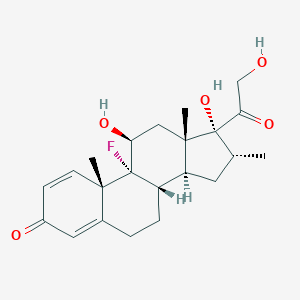Inflammatory joint diseases
Adult: 333 mcg to 5 mg depending on the degree of inflammation and the size and location of the joint. For soft tissues: 2-6 mg. All doses are repeated once every 3-5 days for bursae to once every 2-3 weeks for joints. Refer to detailed product guideline.
Child: 167-333 mcg/kg daily.
Child: 167-333 mcg/kg daily.
Intravenous
Shock
Adult: 1.67-5 mg/kg slowly over several minutes, may be repeated within 2-6 hours until condition is stable and usually for up to 72 hours. Alternatively, initial dose may be followed by continuous infusion of 2.5 mg/kg per 24 hours.
Child: 167-333 mcg/kg daily.
Child: 167-333 mcg/kg daily.
Intravitreal
Diabetic macular oedema, Macular oedema secondary to retinal vein occlusion, Uveitis
Adult: As intravitreal implant containing 700 mcg injected into the affected eye. Retreat after approx 6 months in cases of loss or decrease in vision and/or increase in retinal thickness.
Ophthalmic
Inflammatory eye disorders
Adult: As 0.1% solution: Instill 1 drop 4-6 times daily. Severe conditions: Instill 1 drop hourly, then reduced to 1 drop 4 hourly as the inflammation subsides.
Oral
Anti-inflammatory or immunosuppressive
Adult: Initially, 0.5-9 mg daily in divided doses. Max: 1.5 mg daily. Dosage is individualised and adjusted depending on the disease being treated and patient response. Refer to detailed product guideline.
Child: Initially, 0.02-0.3 mg/kg daily in 3-4 divided doses. Dose depends on disease severity and patient response. Refer to detailed product guideline.
Child: Initially, 0.02-0.3 mg/kg daily in 3-4 divided doses. Dose depends on disease severity and patient response. Refer to detailed product guideline.
Oral
Screening test for Cushing's syndrome
Adult: 2 mg at 11 pm, followed by a blood test for plasma cortisol at 8 am the following morning. Alternatively, 500 mcg 6 hourly for 48 hours, then measure plasma cortisol at 8 am on the 3rd morning (with 24-hour urine collections for determination of 17-hydroxycorticosteroid excretion).
Oral
Acute exacerbations in multiple sclerosis
Adult: Initially, 30 mg daily for 1 week followed by 4-12 mg every other day for 1 month.
Oral
Diagnostic test in differentiating pituitary and ectopic production of ACTH in patients with ACTH-dependent Cushing's syndrome
Adult: 2 mg 6 hourly for 48 hours then measure plasma cortisol at 8 am on the morning following the last dose (with 24-hour urine collections for determination of 17-hydroxycorticosteroid excretion).
Otic/Aural
Otic inflammation
Adult: As 0.1% solution: Instill 3-4 drops into the cleaned aural canal bid or tid, reduced dose gradually if favourable response is obtained. Alternatively, pack the aural canal with a gauze wick saturated with the solution for 12-24 hours, may be repeated as necessary.
Parenteral
Cerebral oedema caused by malignancy
Adult: Initially, 8.3 mg via IV inj followed by 3.3 mg via IM inj 6 hourly until symptoms subside, dose may be reduced after 2-4 days and gradually stopped over 5-7 days. Recurrent or inoperable neoplasms: Maintenance: 1.7 mg given via IV/IM inj bid or tid.
Child: 167-333 mcg/kg daily.
Child: 167-333 mcg/kg daily.
Parenteral
Anti-inflammatory or immunosuppressive
Adult: Initially, 0.4-20 mg daily given via IV/IM inj depending on the condition being treated, may be maintained or adjusted until satisfactory response is achieved.
Child: 167-333 mcg/kg daily.
Child: 167-333 mcg/kg daily.




 Sign Out
Sign Out




